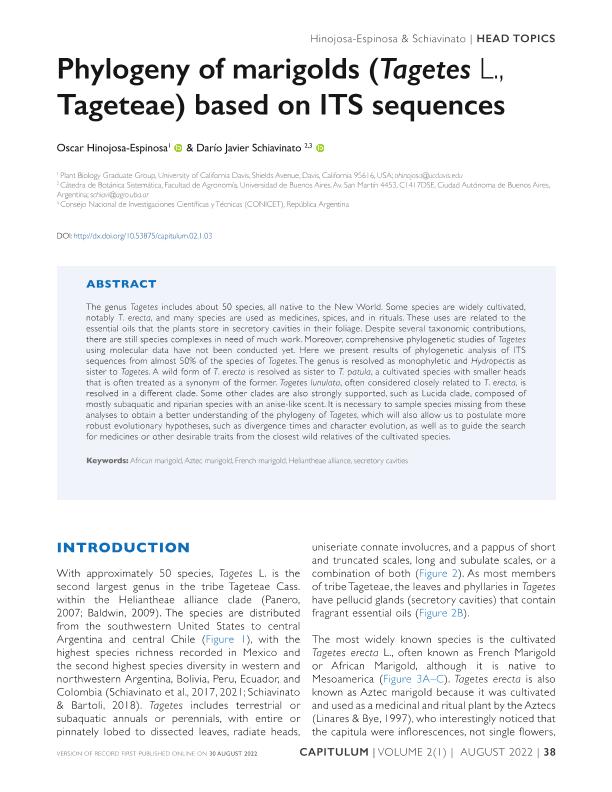Artículo
Phylogeny of marigolds (Tagetes L., Tageteae) based on ITS sequences
Fecha de publicación:
08/2022
Editorial:
The International Compositae Alliance
Revista:
Capitulum
ISSN:
2789-2786
Idioma:
Inglés
Tipo de recurso:
Artículo publicado
Clasificación temática:
Resumen
The genus Tagetes includes about 50 species, all native to the New World. Some species are widely cultivated, notably T. erecta, and many species are used as medicines, spices, and in rituals. These uses are related to the essential oils that the plants store in secretory cavities in their foliage. Despite several taxonomic contributions, there are still species complexes in need of much work. Moreover, comprehensive phylogenetic studies of Tagetes using molecular data have not been conducted yet. Here we present results of phylogenetic analysis of ITS sequences from almost 50% of the species of Tagetes. The genus is resolved as monophyletic and Hydropectis as sister to Tagetes. A wild form of T. erecta is resolved as sister to T. patula, a cultivated species with smaller heads that is often treated as a synonym of the former. Tagetes lunulata, often considered closely related to T. erecta, is resolved in a different clade. Some other clades are also strongly supported, such as Lucida clade, composed of mostly subaquatic and riparian species with an anise-like scent. It is necessary to sample species missing from these analyses to obtain a better understanding of the phylogeny of Tagetes, which will also allow us to postulate more robust evolutionary hypotheses, such as divergence times and character evolution, as well as to guide the search for medicines or other desirable traits from the closest wild relatives of the cultivated species.
Archivos asociados
Licencia
Identificadores
Colecciones
Articulos(OCA PQUE. CENTENARIO)
Articulos de OFICINA DE COORDINACION ADMINISTRATIVA PQUE. CENTENARIO
Articulos de OFICINA DE COORDINACION ADMINISTRATIVA PQUE. CENTENARIO
Citación
Hinojosa Espinosa, Oscar; Schiavinato, Dario Javier; Phylogeny of marigolds (Tagetes L., Tageteae) based on ITS sequences; The International Compositae Alliance; Capitulum; 2; 8-2022; 38-49
Compartir
Altmétricas




